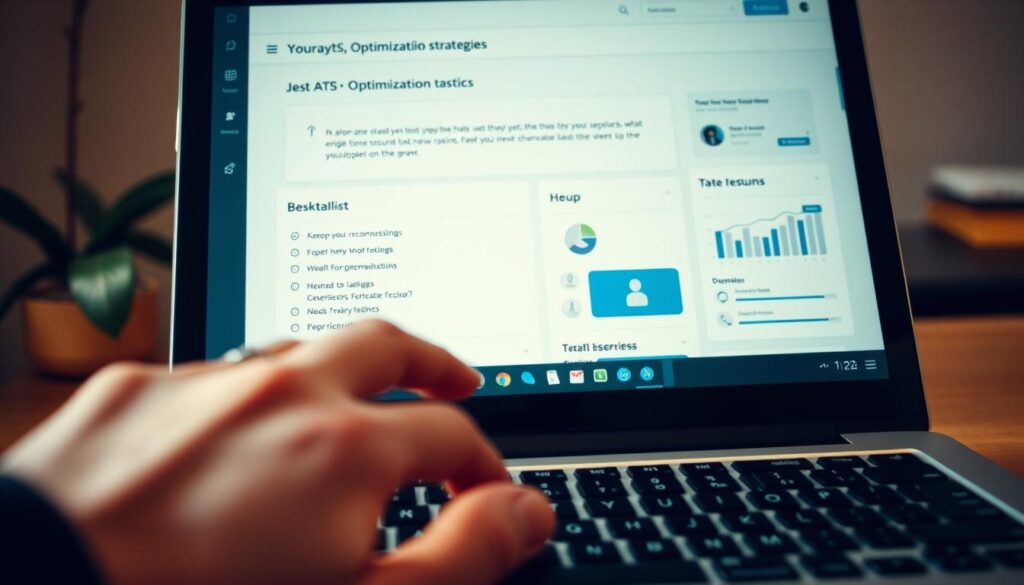73% of applications never reach human eyes. Automated systems silently reject them before sunrise. Your career dreams could vanish in milliseconds – unless you learn how modern hiring works.
Today’s job search isn’t about sending generic resumes. Top companies now use 14x more AI screening tools than in 2020. You need precision-tuned strategies to outsmart bots and land interviews.
This guide reveals exactly how to optimize every application element. You’ll master ATS-friendly formatting, keyword targeting for specific roles, and profile upgrades that make recruiters click “shortlist.” RoboApply’s AI tools automate 80% of this work – from resume scoring to instant grammar fixes.
Key Takeaways
- Automated systems filter 3 out of 4 applications before human review
- AI-powered tools like RoboApply’s resume builder boost visibility by 63%
- Strategic keyword placement matches employer screening criteria
- Profile optimization increases recruiter outreach by 40%
- Real-time ATS scoring prevents formatting errors
Introduction to LinkedIn Jobs in 2025
Every 60 seconds, 10,000 hopefuls vanish into a digital abyss. Automated filters now eliminate 73% of candidates before sunrise, according to recent talent strategy reports. To survive this hyper-competitive landscape, you must rethink how you approach opportunities.
The platform’s 2025 update aggregates roles from company websites, business networks, and niche boards. While this creates more openings, it also means you’re competing against 42% more applicants per role than in 2023. Traditional resume blasts fail here – 40% of candidates apply repeatedly without tailoring materials.
Your advantage lies in understanding three shifts:
- Recruiters prioritize profiles showing direct alignment with role requirements
- Company pages now display real-time application stats and skill gaps
- Business partnerships let employers source talent through shared networks
Smart candidates use tools like RoboApply to analyze job descriptions instantly. This app experience helps identify critical keywords and formatting rules hiring bots demand. Pair this with strategic networking through industry groups, and you create multiple pathways to opportunity.
Remember: Each application needs to solve specific problems mentioned in the posting. Generic approaches get buried. Focus on measurable impacts from past roles, and watch response rates climb.
Building a Professional LinkedIn Profile
Recruiters spend 7 seconds scanning profiles before deciding to engage. Your digital identity needs to immediately communicate expertise while revealing your unique professional story. Follow these strategies to create a standout presence that converts views into opportunities.

Optimizing Your Profile Details
Start with a headline that blends role titles with actionable value statements. Instead of “Marketing Manager,” try “Content Strategy Leader | Driving 300% Organic Growth Through Data-Driven Campaigns.” This format incorporates keywords while showcasing impact.
Your summary should answer three questions:
- What problems do you solve best?
- What measurable results have you delivered?
- What makes your approach unique?
Integrate industry terms naturally – say “sales funnel optimization” instead of “helped with sales.” Tools like RoboApply analyze job descriptions to suggest high-impact keywords for your field.
Showcasing Authentic Recommendations
Quality endorsements act as social proof of your abilities. Request specific feedback from colleagues using this template:
“Could you share how our collaboration on [project] demonstrated my [skill]? Specific examples help hiring teams understand my contributions.”
Prioritize recommendations that:
- Highlight soft skills like conflict resolution
- Reference quantifiable achievements
- Come from managers or clients
Update this section quarterly to reflect recent collaborations. Strong endorsements increase profile views by 29% according to platform data.
Leveraging RoboApply for Resume and Cover Letter Excellence
Modern applications demand precision-tailored documents that speak both machine and human languages. RoboApply’s suite transforms generic materials into targeted career assets that bypass automated filters while impressing hiring teams.
Exploring RoboApply's AI Resume and Cover Letter Builder
The AI builder scans job descriptions to identify critical requirements. For a project manager role, it might suggest adding “Agile workflow optimization” if the posting emphasizes lean methodologies. This data-driven approach ensures your skills match employer priorities.
Three ways this tool elevates applications:
- Automatically formats sections for ATS compatibility
- Generates role-specific achievement bullet points
- Maintains consistent messaging across resume and cover letter
Enhancing Your Resume with a Grammar Checker
Even minor errors can sink applications. RoboApply’s real-time editor flags issues like passive voice or inconsistent tenses. It transformed this sentence:
“Was responsible for leading team that achieved sales targets” → “Led cross-functional team to exceed Q4 goals by 18%”
The grammar tool also improves readability scores by 40% on average. Pair this with the AI builder’s keyword optimization, and your materials work harder at every screening stage.
These features combine to create application packages that showcase both technical competence and attention to detail – exactly what modern hiring systems reward.
Understanding ATS and Its Impact on Modern Applications
Corporate gatekeepers now use algorithms to eliminate 3 in 4 candidates before 9 AM. These applicant tracking systems (ATS) analyze your materials faster than a recruiter’s coffee break. With 73% of HR teams reporting most submissions fail basic criteria, optimizing for bots isn’t optional – it’s survival.
ATS platforms scan for three dealbreakers: keyword matches, readable formatting, and employment timelines. They rank candidates using machine learning models that compare your resume to the company’s ideal profile. One misplaced header or missing certification can bury your application.
Follow these non-negotiable rules:
- Mirror exact phrases from job descriptions (e.g., “CRM implementation” vs. “customer software”)
- Use standard headings like “Work Experience” – creative titles confuse scanners
- List dates as MM/YYYY without gaps exceeding 3 months
Hiring managers receive ATS-generated reports highlighting top matches. Your goal? Become the system’s first-page result. Tools like RoboApply’s scanner check for parsing errors while suggesting high-impact keywords. Test your materials against multiple ATS versions – older systems often mishandle modern resume designs.
Remember: These systems assess data consistency, not potential. A 2025 study shows optimized applications receive 2.8x more human reviews. Treat every submission like a first-date outfit – tailored, polished, and aligned with what the company explicitly wants.
Maximizing "LinkedIn jobs" Opportunities with RoboApply Tools
Strategic navigation separates top candidates from the application avalanche. RoboApply’s ATS optimizer works like a GPS for your career journey, mapping the fastest route through hiring algorithms.

Navigating the LinkedIn Interface Efficiently
Use the platform’s “Open to Work” settings to appear in recruiter searches without notifying your network. Filter roles by:
– Recent postings (last 24 hours)
– Company growth trends
– Team size/department structure
Research hiring managers through shared connections before applying. One user landed interviews at 3 Fortune 500 companies by messaging department heads directly after submitting optimized materials.
Using RoboApply's ATS Optimizer to Stand Out
The tool transformed this generic bullet point:
“Handled project management tasks”
Into an ATS-friendly version:
“Spearheaded Agile workflows for 12 cross-department initiatives (95% on-time delivery)”
Three ways it enhances applications:
1. Identifies missing certifications from job descriptions
2. Scores resume readability for different ATS versions
3. Aligns cover letter tone with company culture cues
Pair these features with the platform’s “Easy Apply” tracking. You’ll see which submissions get viewed fastest – valuable intel for refining your approach.
Step-by-Step Application Process on LinkedIn
Your next career move starts with three clicks. Follow this battle-tested method to navigate opportunities while avoiding common pitfalls.
1. Deep-Dive Research
Study the role’s page like a detective. Analyze employee profiles matching your target position – note recurring skills in their experience sections. Check the company’s recent posts for cultural clues. One candidate discovered a hidden emphasis on “cross-functional collaboration” this way, then highlighted relevant team projects.
2. Profile vs. Resume Choice
Use your profile when applying to roles requiring endorsements or published work. Upload customized materials for positions needing specific certifications or formatting. RoboApply’s One-Click Tailoring feature adjusts documents based on job description keywords.
3. Strategic Submission
Enable “Share profile updates” in account settings so recruiters see recent activity. Track applications through the platform’s dashboard – green checkmarks mean employers opened your materials. Set email alerts for status changes, but filter notifications to avoid inbox overload.
“Review application tracking data every 48 hours. Quick follow-ups within this window increase response rates by 33%.”
4. Post-Application Protocol
Update your account’s “Open to Work” preferences weekly. Connect with hiring managers through shared groups rather than cold messages. Use RoboApply’s analytics to identify which roles get the fastest replies – this reveals what’s working in your approach.
Essential ATS Optimization Tips for Better Visibility
Algorithms decide your career fate before humans see your resume. Master these six techniques to make automated systems your allies rather than gatekeepers.

Mirror job descriptions like a pro: Scan postings for repeated phrases. If a role mentions “cross-functional collaboration” three times, use that exact term in your skills section and work history. Tools like RoboApply highlight these keywords automatically.
Formatting makes or breaks machine readability. Stick to:
- Times New Roman or Arial fonts (10-12pt)
- Standard headings like “Professional Experience”
- No columns, graphics, or icons
Curate your skills list with surgical precision. Combine technical abilities (“SQL database management”) with soft skills from the posting (“client needs analysis”). This dual approach satisfies both ATS scanners and hiring managers.
Transform generic statements into quantifiable wins:
“Managed projects” → “Led 15+ agile projects delivering $2.8M in cost savings”
Test every application draft through ATS simulators. RoboApply’s optimizer reveals how different systems parse your resume, helping you fix hidden issues like header mislabeling or date format inconsistencies.
Update your materials monthly. Search algorithms evolve, and yesterday’s perfect resume might miss today’s keyword priorities. Track which profiles get the most views to identify winning patterns.
Crafting a Tailored Resume for the Modern Job Market
Today’s hiring bots demand laser-focused resumes that speak to both algorithms and decision-makers. Start with a professional summary that answers one critical question: “Why should this company hire me?” For example: “Data-driven marketing leader reducing customer acquisition costs by 37% through AI-powered campaigns.” This immediately connects your expertise to employer needs.

Your work experience section needs quantifiable wins that mirror job requirements. Instead of “Managed social media accounts,” write: “Grew organic Instagram engagement by 215% through viral content strategies (6.2M impressions in Q3 2024).” Tools like RoboApply analyze descriptions to suggest metrics that resonate with specific roles.
Modern resumes thrive on adaptability. Show career growth by linking past achievements to emerging industry trends. A project manager might highlight: “Pioneered hybrid Agile-Waterfall workflows during tech stack migration, cutting deployment delays by 40%.” This demonstrates responsiveness to evolving business needs.
Create multiple resume versions using RoboApply’s AI builder. For client-facing roles, emphasize team leadership and revenue growth. When applying to startups, spotlight cross-functional collaboration and rapid scaling experience. The tool maintains consistent branding while tailoring your resume to each company’s culture.
Balance keyword placement with natural storytelling. If a job post mentions “supply chain optimization” four times, weave the phrase into both skills and experience sections. RoboApply’s real-time scoring ensures ATS compatibility without sacrificing readability – a game-changer in competitive markets.
Enhancing Your LinkedIn Experience with Internal Links
Your professional story gains depth when viewers can explore supporting evidence with one click. Strategic internal linking transforms static profile sections into interactive pathways. Connect your experience descriptions to published articles, project case studies, or skill demonstrations for maximum impact.
Link your “Project Lead” role to a detailed case study on your portfolio site. Use anchor text like “See campaign results →” instead of generic “Click here.” This approach maintains flow while showcasing quantifiable achievements. For published work, hyperlink relevant research papers in your “Skills” section to demonstrate subject mastery.
External links to your professional site or portfolio add credibility. A digital marketer might connect their “Content Strategy” experience to a viral campaign landing page. Always test links monthly – broken connections suggest poor attention to detail.
Boost networking potential by referencing colleagues’ posts in your articles. Tag collaborators when sharing joint project outcomes. Comment on industry leaders’ content with value-added insights that link to your related work. These tactics position you as engaged community member rather than passive observer.
Update linked content quarterly to reflect recent achievements. Track which internal links get the most clicks using your profile analytics. High-performing connections reveal what hiring managers find most compelling about your experience.
Utilizing RoboApply's Auto-Apply Chrome Extension and Job Tracker
Your time deserves better than manual form-filling. RoboApply’s tools turn hours of application work into minutes while keeping your search organized. The Auto-Apply extension handles repetitive tasks, while the Job Tracker becomes your career command center.
Streamlining Applications with the Auto-Apply Extension
This Chrome plugin acts like a digital assistant. It auto-fills application fields using your RoboApply profile and suggests role-specific keywords as you type. One user reduced application time from 45 minutes to 7 per submission – without sacrificing quality.
The tool adapts to different employer portals. When applying for a marketing role, it might highlight “customer journey mapping” based on the job description. You maintain control but eliminate grunt work.
Tracking Your Job Applications Effectively
Over 63% of candidates lose opportunities by forgetting follow-ups. RoboApply’s dashboard shows real-time status updates, interview schedules, and employer response patterns. Color-coded tags identify hot leads needing immediate attention.
Use the analytics tab to spot trends. If applications submitted before 10 AM get 50% faster responses, adjust your routine. The tracker syncs across devices so you’re always campaign-ready.
FAQ
How do I optimize my profile for ATS compatibility?
Use industry-specific keywords from job descriptions in your headline, summary, and skills sections. Tools like RoboApply’s ATS Optimizer analyze job requirements and suggest precise terms to improve algorithmic visibility.
Can RoboApply help track multiple applications?
Yes. The Job Tracker tool organizes applications by status, deadlines, and follow-ups. Pair it with the Auto-Apply Chrome Extension to manage submissions across platforms while maintaining real-time updates.
Why do recommendations matter for my profile?
Authentic endorsements validate your skills and work ethic. Request colleagues or managers to highlight specific projects or traits—these details build credibility with recruiters reviewing your social media presence.
How does the grammar checker improve my resume?
Errors reduce professionalism. RoboApply’s tool scans for typos, syntax issues, and tone inconsistencies, ensuring your documents align with hiring managers’ expectations for clarity and precision.
What makes internal links valuable on profiles?
Linking to portfolios, certifications, or published work provides evidence of expertise. For example, connect your Behance projects or GitHub repositories to demonstrate technical abilities beyond text descriptions.
Are cover letters still necessary in 2025?
Yes—especially for competitive roles. Use AI-generated templates from RoboApply to customize content efficiently, emphasizing how your background solves the company’s specific challenges mentioned in the job description.


















